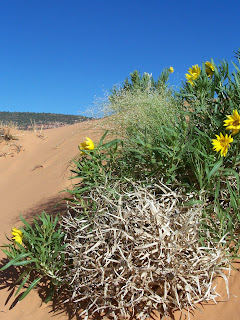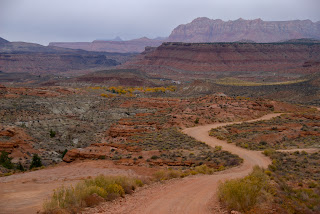
Here's a picture of the Kachina (see above right) we got which is now hanging in the family room. The Kachina is called Umtoinaka, and is the thunder god or making thunder boy. Umtoinaka usually apears at the bean dance to help open the kivas. So now we have to start hosting bean dances.......and opening kivas. Anybody have any idea what a bean dance is?
He was made by Darance Chimerica, a member of the Fire Clan who lives on Münqapi (Moencoupi) on Third Mesa. Darance's Kachinas are easily identified by his painting and the way he carves his feet. Darrance also makes his paints from rocks he gathers himself. I think it will be nice to get a few more to keep Moencoupi company.
After contributing to the Flagstaff economy, we decided against heading in the opposite direction to tour Wupatki National Monument..........another lost opportunity. Instead we decided to head back to Las Vegas. On the map we saw that a ghost town called "White Hills", AKA Silverado, was on the way and we decided to stop by only to learn later that Silverado was washed away in a flash flood and although it still appears on maps, no longer exists. Read the sign in the picture at left. Oh well......we thought we would have better luck visiting the Hoover Dam. Afterall, rising more than 700 feet above the raging waters of the Colorado River, it was called one of the greatest engineering works in history. Hoover Dam, built during the Great Depression, drew men desperate for work to a remote and rugged canyon near Las Vegas. There t
we saw that a ghost town called "White Hills", AKA Silverado, was on the way and we decided to stop by only to learn later that Silverado was washed away in a flash flood and although it still appears on maps, no longer exists. Read the sign in the picture at left. Oh well......we thought we would have better luck visiting the Hoover Dam. Afterall, rising more than 700 feet above the raging waters of the Colorado River, it was called one of the greatest engineering works in history. Hoover Dam, built during the Great Depression, drew men desperate for work to a remote and rugged canyon near Las Vegas. There t hey struggled against brutal heat, choking dust and perilous heights to build a colossus of concrete that brought electricity and water to millions, in the process transforming the American Southwest. Well, all was fine when we stopped at one of the scenic viewpoints and took a couple of pictures (see picture at left). Although we thought it would be bigger, it was scenic. However, they also charge $7 to park in the garage and $11/person to go on the tour, which included access to the visitors center.......what a rip-off. We didn't do the tour, but I did pay $7 dollars to park, which hurt almost as bad as the $60 I paid for breakfast at Mr. Lucky' (refer to Day 1 and 2 of vacation posting).
hey struggled against brutal heat, choking dust and perilous heights to build a colossus of concrete that brought electricity and water to millions, in the process transforming the American Southwest. Well, all was fine when we stopped at one of the scenic viewpoints and took a couple of pictures (see picture at left). Although we thought it would be bigger, it was scenic. However, they also charge $7 to park in the garage and $11/person to go on the tour, which included access to the visitors center.......what a rip-off. We didn't do the tour, but I did pay $7 dollars to park, which hurt almost as bad as the $60 I paid for breakfast at Mr. Lucky' (refer to Day 1 and 2 of vacation posting).
After leaving (what Judy referred to as Hoo-Gives-a-Dam), we slowly made our way back to Las Vegas and hung-out at the Venetian until it was time to return the rent-a-car and wait for our flight. The Venetia n is another of the newer Las Vegas Casinos decked-out like Venice and it was interesting. The Grand Canal Shoppes at the Venetian is a large shopping complex that re-creates Venice's Grand Canal with reproduction storefronts (see picture above) while gondolas transport shoppers around. And yes, the gondoliers were singing and I was ready for the vacation to be over.
n is another of the newer Las Vegas Casinos decked-out like Venice and it was interesting. The Grand Canal Shoppes at the Venetian is a large shopping complex that re-creates Venice's Grand Canal with reproduction storefronts (see picture above) while gondolas transport shoppers around. And yes, the gondoliers were singing and I was ready for the vacation to be over.

 DuBeau Hostel
DuBeau Hostel









 The many settlement sites (one is pictured at right) scattered throughout the monument were built by ancieint Pueblo, more specifically the Snagua, Cohonina, and Kayenta Anasazi. A major population influx began soon after the eruption of Sunset Crater in the 11th century, which blanketed the area with volcanic ash; this improved agricultural productivity and the soil's ability to retain water. Based on a careful survey of archaeological sites conducted in the 1980s, an estimated 2000 immigrants moved into the area during the century following the eruption. Agriculture was based mainly on corn and squash raised from the arid land without irrigation.
The many settlement sites (one is pictured at right) scattered throughout the monument were built by ancieint Pueblo, more specifically the Snagua, Cohonina, and Kayenta Anasazi. A major population influx began soon after the eruption of Sunset Crater in the 11th century, which blanketed the area with volcanic ash; this improved agricultural productivity and the soil's ability to retain water. Based on a careful survey of archaeological sites conducted in the 1980s, an estimated 2000 immigrants moved into the area during the century following the eruption. Agriculture was based mainly on corn and squash raised from the arid land without irrigation.


































